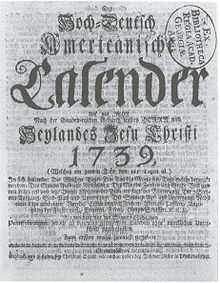Christoph Sauer
| Part of a series on the |
| Schwarzenau Brethren (the German Baptists or Dunkers) |
|---|
 |
| Background |
| Christianity · Protestantism · Anabaptism · Radical Pietism · Radical Reformation |
| Doctrinal tenets |
| Non-creedalism · Trine baptism · Love feast · Feet washing · Holy kiss · Free church · Anointing with oil · Non-resistance · Pacifism · The Brethren Card |
| People |
| Alexander Mack · Louis Bauman · Conrad Beissel · Donald F. Durnbaugh · Vernard Eller · Christoph Sauer · John C. Whitcomb |
| Groups |
| Brethren (Ashland) Church · Brethren Reformed Church · Church of the Brethren · Conservative Grace Brethren · Dunkard Brethren · Grace Brethren · Old Brethren German Baptist · Old German Baptist Brethren · Old Order German Baptist Brethren · Old German Baptist Brethren, New Conference |
| Related movements |
| Amish · Bruderhof · Community of True Inspiration · Hutterites · Mennonites · River Brethren · Religious Society of Friends · Christian Peacemaker Teams |
Christoph Sauer (1695-September 25, 1758) was the first German-language printer and publisher in North America.
Johann Christoph Sauer was born in 1695 in Ladenburg (near Heidelberg), the son of a Reformed pastor. He came to the County (Graftschaft) of Wittgenstein in central Germany as a child with his widowed mother some time between 1700-1710. At the time, its rulers were tolerant of a variety of Pietists and other religious dissenters, most notably Alexander Mack, who would later found the Church of the Brethren in the United States. He had married the widowed Maria Christina (born Gruber) in 1720. The family lived in the village of Schwarzenau, which now belongs to the town of Berleburg though had ties to Laasphe as well.
They emigrated to Pennsylvania in 1724, settling in Germantown. Sauer worked as a tailor before moving in 1726 to Lancaster where he had a 50-acre (200,000 m2) farm. Within a few years, his wife had joined the Ephrata Cloister as "Sister Marcella", leaving Sauer to care for their young son (she returned to the family around 1744). He and his son of the same name returned to Germantown where he worked in a variety of trades and belonged to the Dunkard community. He was successful enough to purchase 6 acres (24,000 m2) where he built a house.

Around 1735, Sauer took up the idea of becoming a printer and publisher. Benjamin Franklin dominated this trade at the time, and was a supplier of printed materials to the large German community around Pennsylvania. Significantly, Franklin used only Roman typefaces. Sauer obtained Fraktur type from a foundry in Frankfurt/Main in 1738 and began to publish almanacs, calendars, books and newspapers in 1739 using a type face that his German readers could more easily read.
The press itself is believed to have come from Berleburg in Wittgenstein, with which he had remained in contact. It had been used by Pietist printers there.
In 1743, Sauer published the first German-language Bible to be printed in North America (the first in any European language). The 1,272 pages were of course hand-set and printed one sheet at a time. It bore the title "Biblia, Das ist: Die Heilige Schrift Alten und Neuen Testaments, Nach der Deutschen Übersetzung D. Martin Luther". (Bible: The Holy Scripture of the Old and New Testaments following the translation of Dr. Martin Luther). 1200 copies were printed. Another 40 years would pass before an English-language Bible would appear in North America.
Controversially, Sauer's Bible emphasized passages most in sympathy with Pietist beliefs. It was well received by the German sects of Pennsylvania, who were in turn influential in what became the Universalist church in the Middle Atlantic and New England states. George de Benneville (1703–1793) was an important influence on the early Universalists and, like Sauer, had sojourned among the Wittgenstein Pietists before coming to America.
Sauer remained active as a printer up until his death on September 25, 1758 in Germantown, but none of his other publications had the impact of the "Sauer Bible." The latter was re-published in 1763 and again in 1776 by his son.
Literature
- Gustav Mori: Der Buchdrucker Christoph Sauer in Germantown. Ein Beitrag zur Geschichte des Buchdruckes in den Vereinigten Staaten von Nordamerika. In: Gutenberg-Jahrbuch 1934
- Kerstin Fischbach: Christoph Sauer. Der erste deutsche Drucker in Amerika. In: Siegerländer und Wittgensteiner in der Neuen Welt / edited by Thomas A. Bartolosch. Siegen, 1999. - S. 61-66